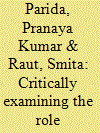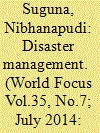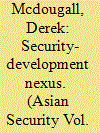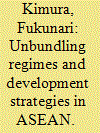|
|
|
Sort Order |
|
|
|
Items / Page
|
|
|
|
|
|
|
| Srl | Item |
| 1 |
ID:
132495


|
|
|
|
|
| Publication |
2014.
|
| Summary/Abstract |
Each day, natural disasters such as ?oods, earthquakes and hurricanes/ cyclones threaten human life and cause severe environmental losses around the world. During the last decade, disasters have affected the lives and assets of almost 2.4 billion people across the world (OCHO, 2010). In India alone since the year 2000, an average 65 million people have been affected by disasters every year. Of this, 8.45 million have been children under the age of ?ve and 3.25 million are pregnant and lactating mothers (UNICEF). Such
humanitarian crises often set back the developmental gains of lesser developed regions by several" decades. Not only do disasters lead to the loss of life and property, but "the immediate a?ermath is a complex situation complicated by issues of logistics, search and rescue, relief distribution, limited accessibility to some of the affected areas, the threat of secondary disasters, the mostly well-intentioned interests of diverse stakeholder groups (which many a times are external to the context of thedisaster), the in?ow of aid material and grants, political interest, media interest and often limited administration capacity. Government is responsible for administrative arrangements dealing with disasters.- Effective policies play a vital role in mitigating the impact of disasters and reducing likely losses of life and property ( Erramilli, 2008) . The disaster management, which is not being treated as a sector by itself, is
undergoing major changes, especially at the institutional and policy levels, which are prompted by various. macro-level factors ( Wagle and Warghade, 2006). Effective coordination among various stakeholders, specifically the Government, the international community and nongovernmental organizations (NGOS) in the aftermath of a disaster is critical to, among other things, a minimization in disaster response time, the proper allocation of resources and the avoidance of duplication of response efforts; Moreover, as economic growth and sustainable development are essential to successful disaster preparedness and mitigation efforts, effective coordination has the potential to strengthen the link between emergency response, preparedness and long-term development strategies.
|
|
|
|
|
|
|
|
|
|
|
|
|
|
|
|
| 2 |
ID:
132497


|
|
|
|
|
| Publication |
2014.
|
| Summary/Abstract |
Hundreds of Natural disasters take place worldwide every year causing irreparable damage to life and property. Earthquakes, ?oods, typhoons, hurricanes,- Tsunamis are among the worst of these natural disasters. Over the last few decades, there has been an alarming increase in the occurrence of natural disasters and the magnitude of their social, economic and environmental impact. During any natural disaster it is usually the" children who suffer the most. The nation witnessed the death of nearly a thousand children during the 2001 Bhuj earthquake. Out of them, 300 died while marching for the Republic day parade. They were in a narrow lane when the earthquake hit causing buildings onboth sides to collapse. It is said thatpnearly 1,884 school buildings collapsed leading to a loss of 5,950 class rooms. About 12000 schools suffered damages making them un?t for children to continue their studies. Fire tragedies, like the one in Kurnbakonam killed 93 children in a school. Another ?re accident in Dabwali, Haryana where a ?re broke out during a schoolfunction took he lives of many school children. Children in schools are the 'most vulnerable group during any disaster. These tragedies reiterate the need for all of us to sit up and think about the safety of these children. It is necessary to make schools safe and hazard proof. For this purpose, it is important to have disaster management, emergency preparedness and response plans at school level.
|
|
|
|
|
|
|
|
|
|
|
|
|
|
|
|
| 3 |
ID:
134103


|
|
|
|
|
| Publication |
2012.
|
| Summary/Abstract |
The article presents a critical evaluation of the concepts of human development and weak statehood and outlines the relationship between them. It is argued that weak statehood has a very significant impact on the success of development strategies even if they stem from human development goals. For example, weak statehood has a direct effect on the provision or non-provision of public goods by the state. Therefore, connecting these concepts provides a perspective for analyzing various issues linked to implementation of development strategies. In conclusion, the article presents the concept of 'functional networking' as a tool for development in the anarchic environment of weak statehood. Functional networking is based on placing unmistakable emphasis on the development of individuals (daily livelihood of families), acceptance of Amartya Sen's condition of the freedom of individuals in terms of decision and opportunity, and the involvement of civil society.
|
|
|
|
|
|
|
|
|
|
|
|
|
|
|
|
| 4 |
ID:
096900


|
|
|
|
|
| Publication |
2010.
|
| Summary/Abstract |
The focus of this article is the relationship between security and development in East Timor and Solomon Islands. External intervention occurred in East Timor in 1999 and 2006, and in Solomon Islands in 2003. Intervention was effective in restoring order in these situations in the short term, but questions remained about long-term strategies for achieving security. Although "development" is proposed as the best way to attain security broadly defined, there are arguments about what development should entail and who should determine its direction. Development strategies giving greater attention to the local level and to customary governance are more likely to achieve legitimacy than those that focus on state-building alone, thus contributing to greater security in the long term.
|
|
|
|
|
|
|
|
|
|
|
|
|
|
|
|
| 5 |
ID:
167054


|
|
|
|
|
| Summary/Abstract |
The Slow City concept advocates the development of cities by combining modern technologies and traditional lifestyles to provide efficient transportation and communication and high quality of life for the residents. This study investigates the present situation, development approach and public acceptability of the Slow City concept in China. Based on the theory and the practical application of the Slow City concept in major member countries, the development process of Slow City can be divided into three stages: the origin stage, the development stage and the promotion stage. This study shows that the Slow City development in China is at the third stage. Due to diverse economic foundations, cultural traditions and the sociopolitical environment, the Slow City in China represents different features compared to the Slow City in Europe. A systematic analysis provides a better understanding of the situation of the Chinese Slow City. Then, the authors evaluate the degree of acceptability of the Slow City concept in China based on three aspects: the understanding, the awareness, and the popularity of the Slow City. Based on the results, this paper suggests optimistic growth opportunities for the Slow City in China and provides several strategies with regard to diverse perspectives.
|
|
|
|
|
|
|
|
|
|
|
|
|
|
|
|
| 6 |
ID:
134105


|
|
|
|
|
| Publication |
2012.
|
| Summary/Abstract |
Nations that have sought to overcome the resource curse and other barriers to economic growth have pursued, for some time, greater development through a number of strategies: from import substitution in the 1950s to current strategies based on micro-finance and human-capabilities approaches. Needless to say, the international community is still searching for the elusive Holy Grail of an optimal development strategy. One strategy that has attracted greater attention and a growing number of adherents is that of promoting the transition to a knowledge economy. This paper is about one such nation, Saudi Arabia. In analyzing the Kingdom's quest for a knowledge economy, this article hopes to shed light on the anatomy of the strategy itself and identify important preconditions for and barriers to the strategy's success. The case study of Saudi Arabia's quest for a knowledge economy carries important implications and lessons for other nations, especially those with resource economies that are seeking effective plans of economic development and transition.
|
|
|
|
|
|
|
|
|
|
|
|
|
|
|
|
| 7 |
ID:
132663


|
|
|
|
|
| Publication |
2014.
|
| Summary/Abstract |
This study documents and analyzes the role of health risk perceptions and other associated concerns of wind energy development (henceforth WED) in Ontario. Drawing on the risk society framework, we conduct a longitudinal media content analysis to document and analyze perceptions of and responses to WED over a nine year period. Attention is paid to temporal variations in responses relative to Ontario×s Green Energy Act (2009) (henceforth GEA); legislation aimed at the rapid expansion of renewable energy. The study reveals that the most radical forms of resistance to WED on health grounds are driven by perceived injustices in the treatment of potential at-risk citizens and citizens with health concerns. The GEA is fuelling these perceptions of injustices in subtle and nuanced ways, particularly by acting as a major confounder to health risk concerns. Contrary to several existing studies, we problematize the use of financial incentives to foster the development of wind energy. We also provide policy recommendations which include the need for increased public engagement in the WED process, the importance of using third party health and environmental assessments to inform developments as well as the need for post-development strategies to address ongoing community concerns.
|
|
|
|
|
|
|
|
|
|
|
|
|
|
|
|
| 8 |
ID:
158548


|
|
|
|
|
| Summary/Abstract |
This paper extends the conceptual framework of “unbundling” proposed by Baldwin (2016), and tries to provide a starting point for reorganizing development strategies of ASEAN member states (AMS). While AMS have largely been successful in utilizing the mechanics of the second unbundling with a reduction in communication costs, there still exists a lot of room for exploiting its benefits. In addition, a new wave of the third unbundling, which comes with a reduction in face-to-face costs, has already arrived at ASEAN, and AMS must start incorporating it into their development strategies.
|
|
|
|
|
|
|
|
|
|
|
|
|
|
|
|
|
|
|
|
|